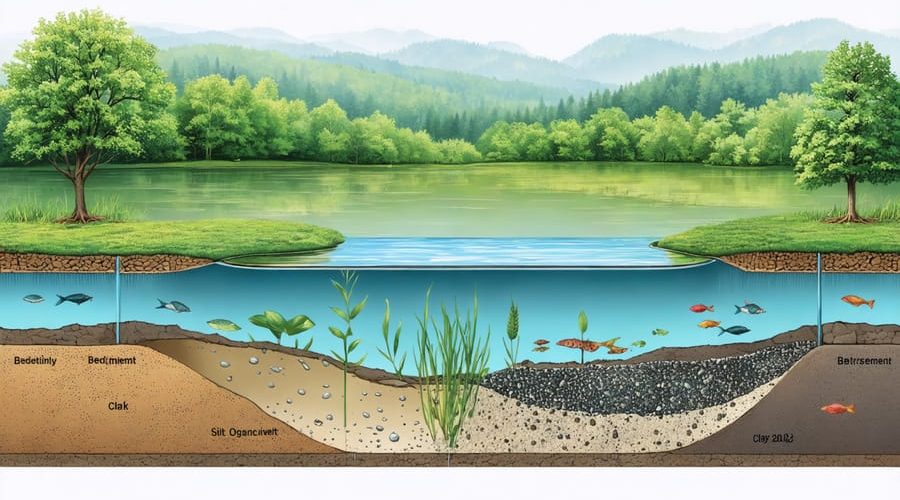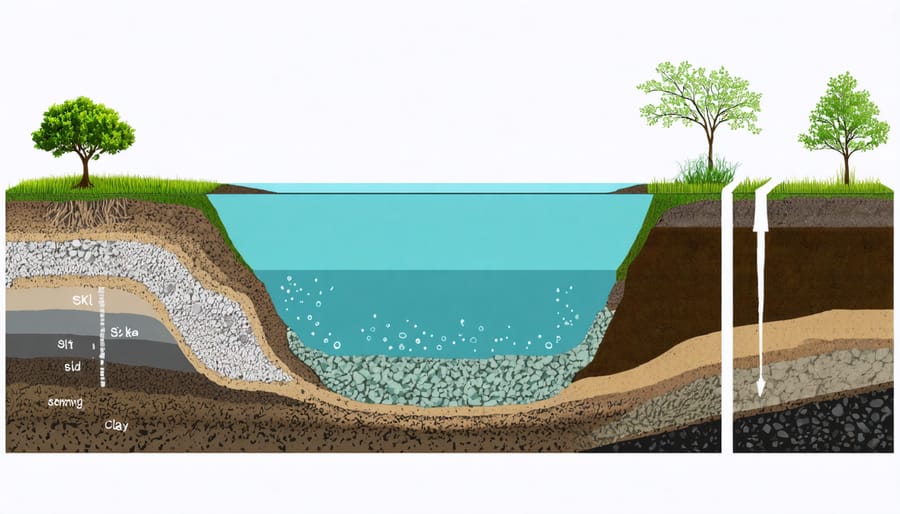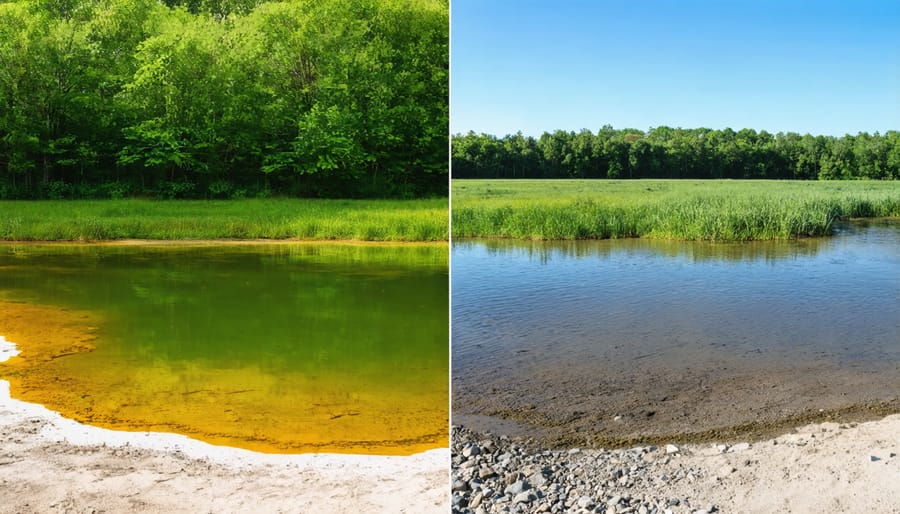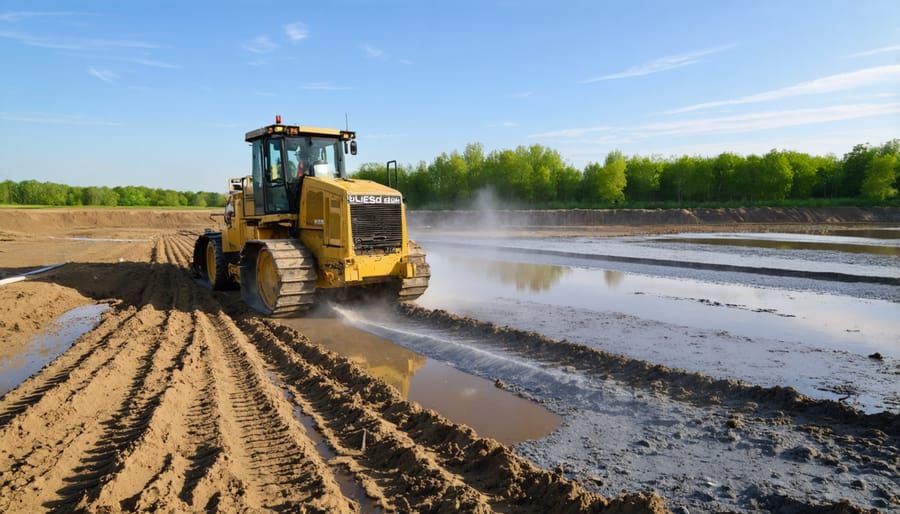
Save Your Pond: Smart Solutions for Lake Sediment Problems
Lake sediment stands as the silent storyteller of our water bodies, recording centuries of environmental changes while profoundly impacting pond and lake health today. This natural accumulation of organic matter, minerals, and weathered materials shapes water quality, affects aquatic life, and creates both challenges and opportunities for pond owners.
At the bottom of every pond lies a complex ecosystem within the sediment layer, where beneficial bacteria break down organic matter and nutrients cycle through the system. However, excessive sediment buildup can trigger a cascade of issues, from decreased water depth to elevated nutrient levels that fuel unwanted algae growth.
For pond enthusiasts and property owners, understanding lake sediment isn’t just about maintaining water clarity – it’s about preserving the delicate balance that keeps their aquatic paradise healthy. Whether you’re dealing with a backyard pond or managing a larger water feature, the relationship between sediment management and water quality directly impacts your pond’s beauty, functionality, and long-term sustainability.
This dynamic interaction between sediment and water quality forms the foundation of effective pond management, making it essential knowledge for anyone serious about maintaining their water feature’s health and beauty.
Understanding Lake Sediment in Your Pond
Common Types of Pond Sediment
Pond sediment typically comes in two main varieties: organic and inorganic materials. Organic sediment consists primarily of decomposed plant matter, fallen leaves, dead algae, and other natural debris that sinks to the bottom of your pond. This type of sediment often appears dark brown or black and has a somewhat spongy texture when disturbed.
Inorganic sediment, on the other hand, includes materials like sand, silt, clay, and small rocks that wash into your pond from surrounding areas. This type of sediment usually has a more granular texture and can range in color from light tan to reddish-brown, depending on your local soil composition.
You might also encounter a mix of both types in what’s called composite sediment. This is especially common in backyard ponds where leaves fall directly into the water while soil erosion brings in mineral particles from the surrounding landscape.
The bottom layer of sediment, often referred to as “muck,” is typically the oldest and most decomposed material. This layer can be quite dense and sticky, making it challenging to remove. Above this, you’ll usually find newer deposits that haven’t fully broken down yet.
Understanding these different types of sediment is crucial for proper pond maintenance, as each type may require different management approaches. Regular monitoring of sediment accumulation helps prevent excessive buildup and maintains a healthy pond ecosystem.

Where Does Sediment Come From?
Lake sediment comes from various sources, both natural and human-influenced. One of the primary contributors is surface runoff, which occurs when rain or melting snow washes soil particles, organic matter, and debris into the lake. During heavy rainfall, this process intensifies, especially in areas without proper vegetation to prevent erosion and runoff.
Natural decomposition also plays a significant role in sediment formation. As aquatic plants, fallen leaves, and other organic materials break down, they create a layer of organic sediment at the bottom of the lake. This process is continuous and particularly noticeable during autumn when leaves fall into the water.
Shoreline erosion contributes substantially to sediment accumulation. Wave action and fluctuating water levels gradually wear away at the banks, causing soil and rocks to collapse into the water. In areas with steep slopes or limited vegetation, this process happens more rapidly.
Human activities near lakes can accelerate sediment buildup. Construction projects, agricultural practices, and landscape modifications often expose bare soil, which can easily wash into nearby water bodies. Even seemingly minor activities like mowing too close to the water’s edge can increase sediment flow into your lake or pond.
The Impact of Excess Sediment

Effects on Water Quality
Lake sediment plays a crucial role in shaping your pond’s water quality, affecting everything from oxygen levels in ponds to overall clarity. As sediment builds up on the bottom, it creates a complex relationship with your pond’s ecosystem that every pond owner should understand.
Think of sediment as a double-edged sword when it comes to nutrients. While it can store beneficial nutrients that aquatic plants need, excessive sediment often leads to nutrient overload. This can trigger algae blooms that turn your crystal-clear pond into a murky green soup. When this happens, sunlight struggles to penetrate the water, making it difficult for beneficial plants to thrive.
The impact on water clarity is usually the first thing you’ll notice. As sediment particles float in the water column, they create that cloudy appearance we all want to avoid. But the real concern lies beneath the surface. When organic sediment decomposes, it consumes oxygen that fish and other aquatic life need to survive. This process can be particularly problematic during warm summer months when oxygen levels are naturally lower.
Heavy sediment accumulation can also affect your pond’s depth over time, potentially creating shallow areas where unwanted plants can take root. By understanding these effects, you can better maintain your pond’s health and keep it looking beautiful year-round.
Impact on Pond Life
Sediment accumulation in your pond can significantly affect the delicate balance of life within your water garden. Fish are particularly sensitive to excessive sediment, as it can clog their gills and make it harder for them to breathe. When sediment clouds the water, it reduces visibility, making it difficult for fish to find food and avoid predators.
Aquatic plants also struggle when sediment builds up. Too much muck at the bottom can smother plant roots, preventing them from absorbing essential nutrients. Floating plants might find it harder to anchor themselves, while submerged plants may receive less sunlight due to murky water conditions.
The impact on beneficial bacteria is equally important. These microscopic helpers break down waste and maintain water quality, but excessive sediment can overwhelm their natural cleaning abilities. When there’s too much organic matter settling at the bottom, bacteria may not be able to process it quickly enough, leading to poor water quality and potential algae blooms.
However, it’s worth noting that some sediment is natural and even beneficial. A thin layer provides essential minerals for plants and creates microhabitats for small organisms that fish feed on. The key is maintaining the right balance – enough sediment to support life, but not so much that it becomes harmful to your pond’s ecosystem.
Practical Sediment Management Solutions
Prevention Strategies
Preventing sediment buildup is much easier than dealing with it after the fact. The key to success lies in implementing an integrated lake management approach that addresses multiple factors simultaneously.
Start by establishing a buffer zone of native plants around your lake’s edges. These plants act as natural filters, catching soil and debris before they enter the water. Aim for a strip at least 3-6 feet wide with a mix of grasses and deep-rooted plants.
Managing water flow is crucial. Install erosion control measures like stone riprap or biologs along areas where runoff enters your lake. Direct incoming water through settling basins or constructed wetlands to trap sediment before it reaches the main body of water.
Regular maintenance of your watershed area makes a big difference. Keep nearby paths and driveways well-maintained, repair any erosion spots promptly, and ensure proper drainage systems are in place. During construction projects near your lake, always use silt fences and other barriers to prevent soil from washing into the water.
Consider adding aquatic plants strategically throughout your lake. Water lilies, rushes, and other submerged plants help slow water movement and trap suspended particles. Plus, they add beautiful natural elements to your water garden!
Don’t forget about proper aeration – it helps keep organic matter decomposing efficiently rather than settling to the bottom. Installing bottom diffusers or surface aerators can significantly reduce organic sediment accumulation while improving overall water quality.
Removal Techniques
When it comes to removing lake sediment, there are several effective methods suitable for both DIY enthusiasts and professional services. For smaller ponds and water features, manual removal can be a cost-effective solution. Using a long-handled pond net or rake, you can carefully scrape the bottom to collect accumulated sediment. This works best when the water level is lowered, making it easier to reach the bottom.
For more extensive sediment removal, a pond vacuum is an excellent tool that many pond owners find invaluable. These specialized devices work like underwater vacuum cleaners, sucking up sediment while leaving the water behind. You can rent these from most garden centers or hardware stores if you don’t want to invest in purchasing one.
Professional dredging is the most thorough option for larger lakes and ponds. This process involves using specialized equipment to remove built-up sediment from the bottom. While more expensive, dredging can significantly improve water quality and restore depth to your water feature. Hydraulic dredging, which uses water pressure to loosen and remove sediment, is particularly effective and causes minimal disruption to aquatic life.
Preventive measures are just as important as removal techniques. Installing sediment traps or settling basins around your pond can catch debris before it enters the water. Regular maintenance of these features, along with proper erosion control around the shoreline, can significantly reduce future sediment buildup.
For those interested in eco-friendly solutions, biological treatments can help break down organic sediment naturally. These treatments introduce beneficial bacteria that digest organic matter, though they work more slowly than mechanical removal methods. Combined with regular skimming and proper filtration, these treatments can help maintain clearer water and reduce the frequency of major cleanouts.

Maintenance Schedule
A well-planned maintenance schedule is essential to manage lake sediment effectively and maintain water quality throughout the year. Here’s a seasonal breakdown of recommended tasks:
Spring (March-May):
– Conduct a thorough bottom survey to assess winter sediment accumulation
– Remove large debris that settled during winter
– Test water parameters and document baseline conditions
– Begin regular skimming of floating debris (weekly)
Summer (June-August):
– Monitor sediment buildup in high-traffic areas monthly
– Clean filtration systems every 2-3 weeks
– Remove any visible algae growth
– Check sediment depth near inlets and outlets
Fall (September-November):
– Install protective netting to catch falling leaves
– Increase debris removal frequency to twice weekly
– Plan major sediment removal if needed
– Document problem areas for winter planning
Winter (December-February):
– Maintain ice-free areas if possible
– Monitor water levels
– Plan for spring maintenance
– Review annual sediment accumulation data
Year-round tasks:
– Monthly water quality testing
– Regular visual inspections
– Record keeping of sediment levels
– Immediate removal of visible debris
For smaller ponds, this schedule can be adjusted based on specific needs and conditions. Remember that prevention is often easier than correction, so staying consistent with maintenance tasks will help reduce major sediment issues in the long run.
Managing lake sediment doesn’t have to be overwhelming. As we’ve explored throughout this guide, understanding and controlling sediment is crucial for maintaining a healthy, beautiful water feature. Regular monitoring and preventive measures can save you time, money, and effort in the long run.
Remember that sediment management is an ongoing process, not a one-time task. Start by implementing basic erosion control measures around your pond or lake, such as maintaining vegetative buffers and stabilizing shorelines. Keep up with regular maintenance tasks like removing excess organic matter and monitoring water quality.
For smaller ponds, manual removal methods might be sufficient, while larger lakes may require professional intervention. Whatever the size of your water feature, addressing sediment issues early prevents more significant problems down the line.
Don’t forget that a healthy ecosystem is your best ally in sediment management. Encourage beneficial plants and organisms that help maintain water clarity and reduce organic buildup. Consider implementing multiple management strategies for the best results.
By taking a proactive approach to sediment control, you’re not just maintaining water quality – you’re protecting your investment and creating a more enjoyable outdoor space for years to come. Start small, be consistent, and don’t hesitate to seek expert advice when needed. Your pond or lake will thank you with clearer water and a healthier ecosystem.
